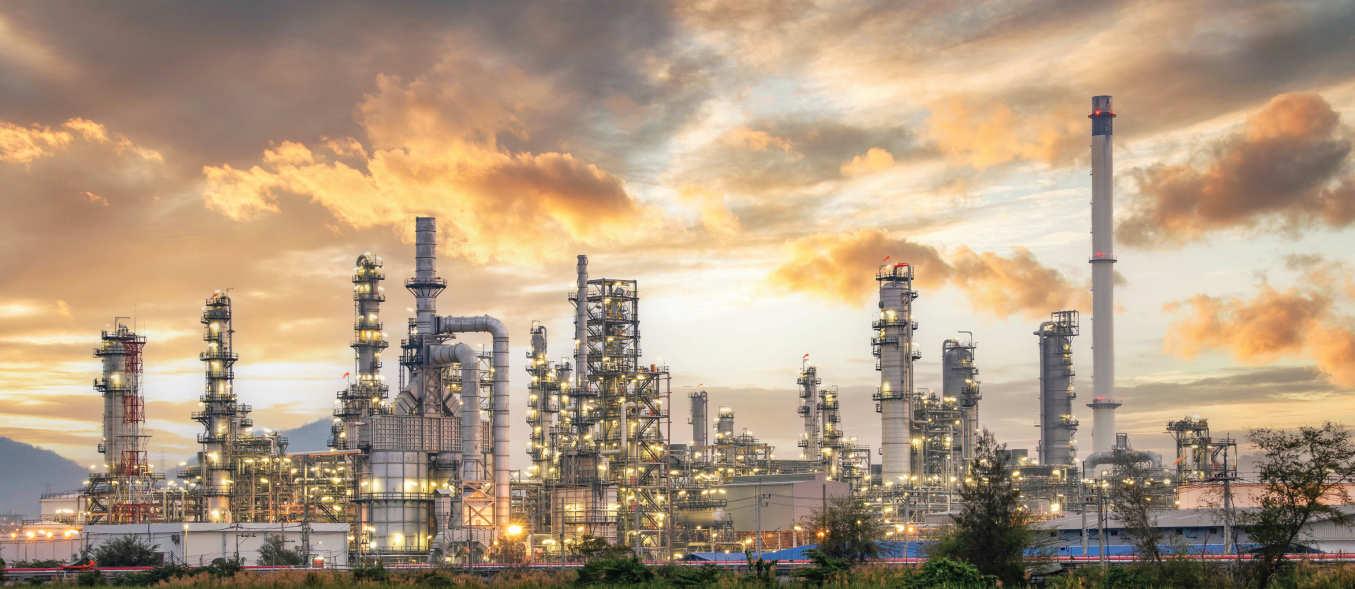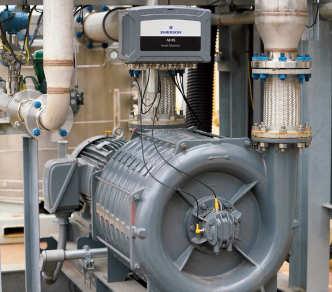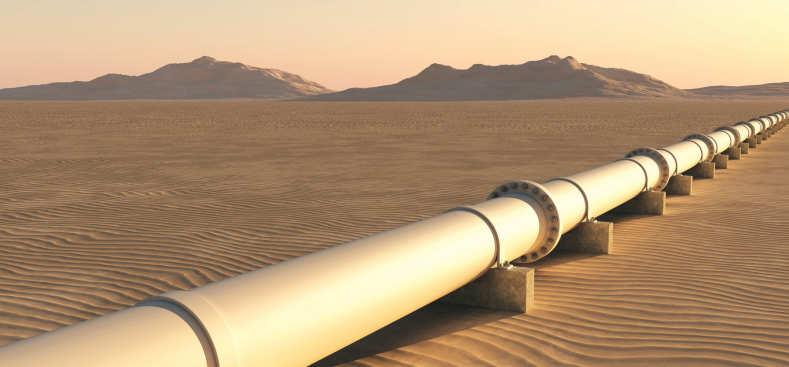
8 minute read
Protecting pumps, production and people
Durgesh Jha, Middle East & Africa sales leader – Reliability Solutions at Emerson Automation Solutions, discusses the benefits of continuous pump monitoring.
It is estimated that pumps account for 7% of the total maintenance costs of a refinery.
Image Credit: Adobe Stock
PUMPS ARE ESSENTIAL in the daily operations of industrial oil production processes. The challenge most operators face is that these pumps begin to degrade as soon as they are running, with a roster of potential risks that producers must keep an eye out for. Fluid loss is one of those risks which can effectively be reduced through dual seals, but for a compromised reservoir tank on an unmonitored pump, this can mean serious complications that can lead to the depletion of seal fluid levels from lack of lubrication and eventually, seal damage. Mechanical pump switches also have a tendency to stick, which can be detrimental to the entire unit.
All these point to lack of monitoring on the pumps, which results in reduced productivity, operational shutdown, expensive repairs, and lack of compliance to regulations. Along with fluid loss, it is also important to note the safety risk brought by dangerous fumes and threat of combustion within the facility.
In addition, with the global shift towards sustainability, stringent laws and regulations are being built around greenhouse gas emissions reduction where it is becoming imperative for producers to reduce their fugitive emissions through the improvement of their overall operations. Measures can include improving leak detection and repair, installing vibration and temperature sensors and applying state-of-the-art seals, which can all be enabled with predictive maintenance.
Offshore platforms often operate in harsh conditions far from land, which calls for high reliability assets, especially pumps. These pumps are usually maintained and inspected manually with a technical crew flying to the locations at regular intervals. It is estimated that pumps account for 7% of the total maintenance costs of a refinery, and pump failures are responsible for 0.2% of lost production.
What if you had a cost effective, easy to apply solution for monitoring these pumps 24/7?
Pumps are, without question, significant players for maintaining production schedules. In process plants, as many as 90% of process pumps are monitored manually, or not monitored at all. Statistically, pumps will fail or suffer degraded operations every 12 months. This cycle provides a great opportunity for producers to deploy cutting edge technologies for pump monitoring that can predict failures and make it simple to take proactive measures in safety, regulations, and shutdowns.
Each operation is different, which is why it is highly important to carefully evaluate the factors at play in selecting and deploying solutions. These factors can be the current pump installation, maintenance and operational challenges faced by the team, current and future KPIs, budget, and return on investment.
A simple solution can start with an offline route-based condition monitoring, to an advanced solution involving online wireless or online continuous monitoring technology to collect key parameters like vibration, fluid leak, temperature, and feed to analysis software. The software will compare actual sensor readings to the pump’s predictive, ideal values. It then provides exception-based notifications of developing problems to operators, along with the pump’s diagnosis and prioritisation.
Wireless monitoring of key parameters of a pump using pervasive sensors has helped the industry make the leap from reactive to predictive maintenance. Emerson’s wireless vibration and temperature monitoring is one of the pioneering technologies that leveraged wireless solutions to improve data collection in pumps. It is now deployed across global major oil and gas end users due to its easy deployment in both onshore and offshore locations, enabling operators to start small scale with a low budget and minimal risks, realise quicker ROI and expand further at their own pace.
Now, digital solutions are becoming more accessible with the recent technological advancements in machine learning and analytics, which can help address key pump issues. These include Emerson’s Plantweb Optics Analytics Pump Template, a ready-touse platform agnostic software component that allows users to monitor, manage, analyse and create visibility on the performance of pumps. Similarly, Emerson's PeakVue technology cuts through the complexity of pump analysis to provide a simple, reliable indication of equipment health through a single trend.
Edge Analytics lends another avenue for the industry to monitor their assets. Emerson’s Edge Analytics device, AMS Asset Monitor, can be installed near to the pump to collect vibrations and other process parameters and deliver embedded prescriptive analytics to determine pump condition while broadcasting the results of the analysis in an easy-to-understand format. When connected to Plantweb Optics, users can receive updates in their office or on their mobile device with embedded prescriptive analytics that deliver easy-to-understand results for operators with limited to no prior knowledge and experience around pump maintenance. These solutions enable operators to be proactive in the way they maintain their operations, offering a wide range of opportunities to improve their KPIs, make relevant decisions based on analytics, learn more about their operations with predictive models, and scale up to enterprise-wide pump monitoring. By deploying such solutions and software, they can prevent the challenges in pump performance and condition and unplanned shutdowns, and start building towards better asset assessments, best practices, and expert knowledge sharing.

Small, easy-to-install sensors like this vibration monitor can warn if an asset needs attention well before a turnaround.
Image Credit: Emerson Automation Solutions



The AMS Asset Monitor is an edge analytics device that delivers the benefits of continuous monitoring to more plant assets at far less installation expense.
BRIGHT PROSPECTS FOR AFRICA’S PIPELINES
Strong oil and gas prices, growing demand and the drive to increase regional trade and boost international energy exports are catalysing pipeline developments in Africa.
BUOYANT OIL AND gas prices have strengthened the business case for many pipeline projects globally, according to energy consultancy Westwood Energy.
“In Africa, both the 1,443 km East Africa Crude Oil Pipeline (EACOP) and the 823 km pipeline for the Lokichar project are moving forward after multiple delays,” comments the energy consultancy.
The construction of these two pipelines will be a significant boost to Africa’s annual pipeline installations, which have historically fluctuated, it adds. The pipeline for the Tullow Oil Lokichar project in Kenya will connect Lokichar to Lamu port on the Indian ocean, while the EACOP pipeline currently under construction, which will be the longest electrically heated pipeline in the world, will transport Uganda’s crude oil to Tanga port in Tanzania for onward export.
Another project which appears to be moving forward is the US$25bn Nigeria-Morocco Gas Pipeline Project, currently at the design stage, which is set to bring Nigerian gas to 13 countries in West and North Africa, with possible extension to Spain for the European market. Upon completion, the 6,000 km pipeline will be the longest offshore pipeline in the world and the second longest pipeline ever. OPEC is reported to be funding the second phase of the FEED study, which has been awarded to Worley. Project management consultancy services for this have been awarded to a joint venture of ILF Consulting Engineers and DORIS Engineering, involving onshore and offshore pipeline and compressor station planning, technical surveying, environmental and social impact assessment, land acquisition studies and project implementation framework.
Also exploiting Nigeria’s gas resources is the 614 km Ajaokuta-Kaduba-Kano (AKK) gas pipeline project running from southern Nigeria to Kano in the north. The long-term aim of this is to supply gas to Europe through the Trans-Saharan Gas Pipeline (TSGP) project, for which it is the first phase. The EU, which currently imports 14% of its LNG supplies from Nigeria, is reported to be seeking additional gas supplies from the West African country in the face of potential Russian supply cuts.
Westwood points out that despite positive developments, the pipeline market remains precarious. Commodity price fluctuations remain a threat, and supply chain issues such as the removal of Russian steel from many international markets, are potentially limiting the annual pipe supply, with subsequent delays to pipeline construction and increasing costs.
Environmental issues are increasingly influencing developments. For example in the case of the Lockichar pipeline, the length of the pipeline was increased by 9% as a result of being diverted away from areas where it could have adverse environmental implications on wildlife, while the NMGC project investigates the potential to use renewable energy sources to operate the pipeline and reduce its CO2 footprint.
The EACOP pipeline, which will be buried to minimise the impact on the environment, has been subject to pressure from activists, who argue that the construction of the pipeline will displace thousands of families, destroy farmland, devastate ecosystems across the region and threaten water resources – not to mention generating significant CO2 emissions. As a result, some bankers and insurers have been reluctant to back it.
Theft and vandalism also pose a challenge, particularly in Nigeria, which has been plagued for years by rampant oil theft from pipelines. The TransNiger Pipeline, which is capable of transporting around 180,000 barrels of crude per day, has been dry since mid-June this year due to theft.

Africa pipeline projects are moving forward.









